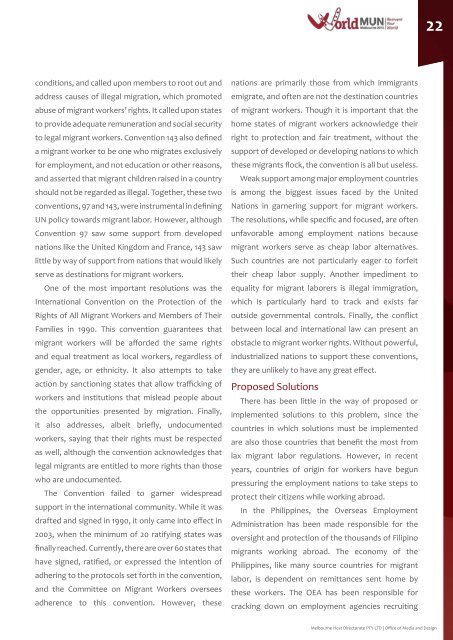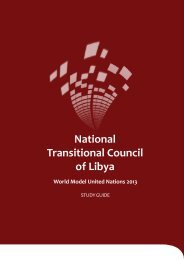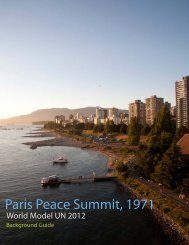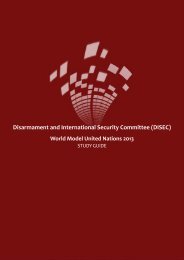SPECPOL - World Model United Nations
SPECPOL - World Model United Nations
SPECPOL - World Model United Nations
Create successful ePaper yourself
Turn your PDF publications into a flip-book with our unique Google optimized e-Paper software.
conditions, and called upon members to root out and<br />
address causes of illegal migration, which promoted<br />
abuse of migrant workers’ rights. It called upon states<br />
to provide adequate remuneration and social security<br />
to legal migrant workers. Convention 143 also defined<br />
a migrant worker to be one who migrates exclusively<br />
for employment, and not education or other reasons,<br />
and asserted that migrant children raised in a country<br />
should not be regarded as illegal. Together, these two<br />
conventions, 97 and 143, were instrumental in defining<br />
UN policy towards migrant labor. However, although<br />
Convention 97 saw some support from developed<br />
nations like the <strong>United</strong> Kingdom and France, 143 saw<br />
little by way of support from nations that would likely<br />
serve as destinations for migrant workers.<br />
One of the most important resolutions was the<br />
International Convention on the Protection of the<br />
Rights of All Migrant Workers and Members of Their<br />
Families in 1990. This convention guarantees that<br />
migrant workers will be afforded the same rights<br />
and equal treatment as local workers, regardless of<br />
gender, age, or ethnicity. It also attempts to take<br />
action by sanctioning states that allow trafficking of<br />
workers and institutions that mislead people about<br />
the opportunities presented by migration. Finally,<br />
it also addresses, albeit briefly, undocumented<br />
workers, saying that their rights must be respected<br />
as well, although the convention acknowledges that<br />
legal migrants are entitled to more rights than those<br />
who are undocumented.<br />
The Convention failed to garner widespread<br />
support in the international community. While it was<br />
drafted and signed in 1990, it only came into effect in<br />
2003, when the minimum of 20 ratifying states was<br />
finally reached. Currently, there are over 60 states that<br />
have signed, ratified, or expressed the intention of<br />
adhering to the protocols set forth in the convention,<br />
and the Committee on Migrant Workers oversees<br />
adherence to this convention. However, these<br />
nations are primarily those from which immigrants<br />
emigrate, and often are not the destination countries<br />
of migrant workers. Though it is important that the<br />
home states of migrant workers acknowledge their<br />
right to protection and fair treatment, without the<br />
support of developed or developing nations to which<br />
these migrants flock, the convention is all but useless.<br />
Weak support among major employment countries<br />
is among the biggest issues faced by the <strong>United</strong><br />
<strong>Nations</strong> in garnering support for migrant workers.<br />
The resolutions, while specific and focused, are often<br />
unfavorable among employment nations because<br />
migrant workers serve as cheap labor alternatives.<br />
Such countries are not particularly eager to forfeit<br />
their cheap labor supply. Another impediment to<br />
equality for migrant laborers is illegal immigration,<br />
which is particularly hard to track and exists far<br />
outside governmental controls. Finally, the conflict<br />
between local and international law can present an<br />
obstacle to migrant worker rights. Without powerful,<br />
industrialized nations to support these conventions,<br />
they are unlikely to have any great effect.<br />
Proposed Solutions<br />
There has been little in the way of proposed or<br />
implemented solutions to this problem, since the<br />
countries in which solutions must be implemented<br />
are also those countries that benefit the most from<br />
lax migrant labor regulations. However, in recent<br />
years, countries of origin for workers have begun<br />
pressuring the employment nations to take steps to<br />
protect their citizens while working abroad.<br />
In the Philippines, the Overseas Employment<br />
Administration has been made responsible for the<br />
oversight and protection of the thousands of Filipino<br />
migrants working abroad. The economy of the<br />
Philippines, like many source countries for migrant<br />
labor, is dependent on remittances sent home by<br />
these workers. The OEA has been responsible for<br />
cracking down on employment agencies recruiting<br />
22<br />
Melbourne Host Directorate PTY LTD | Office of Media and Design

















